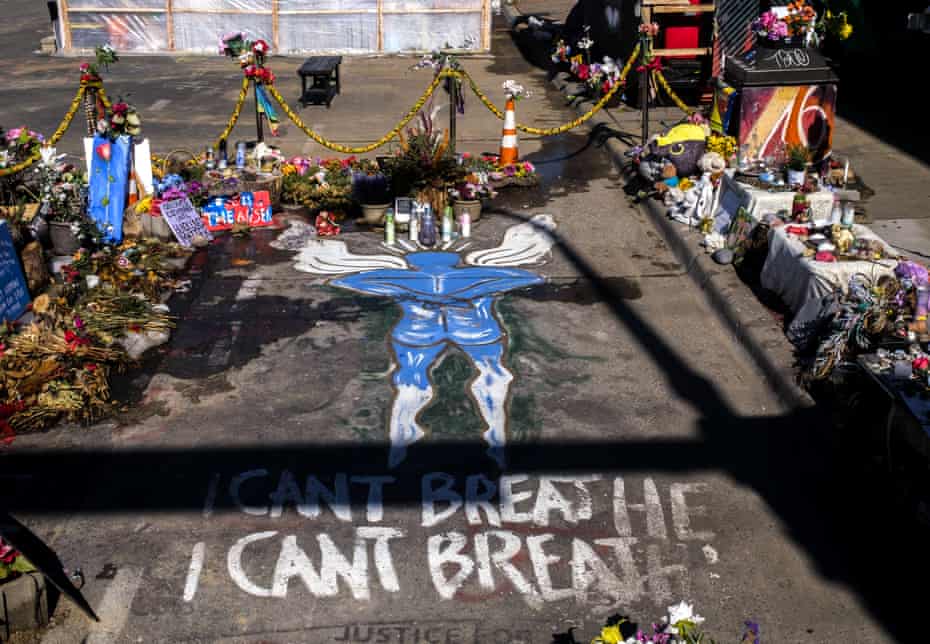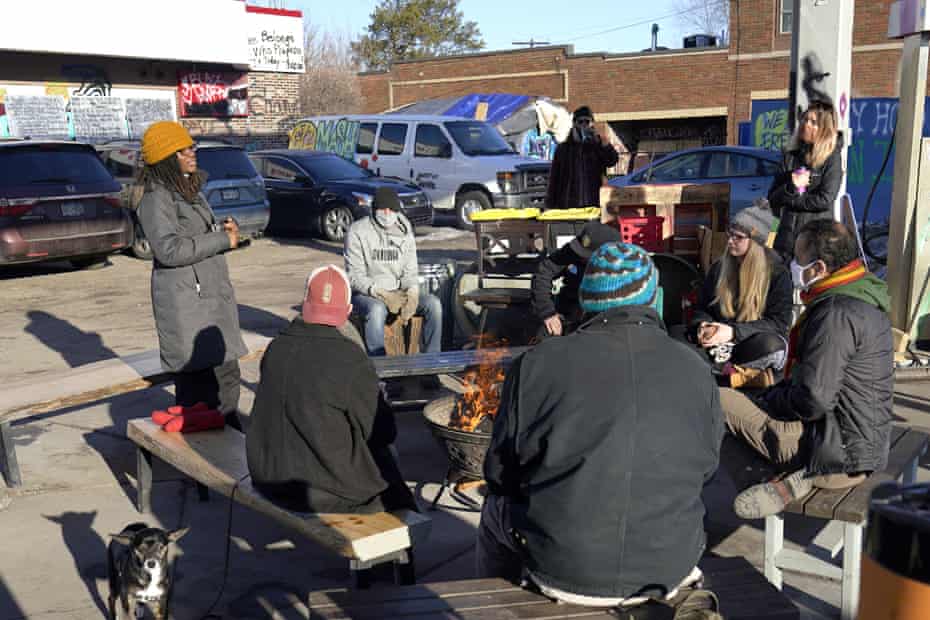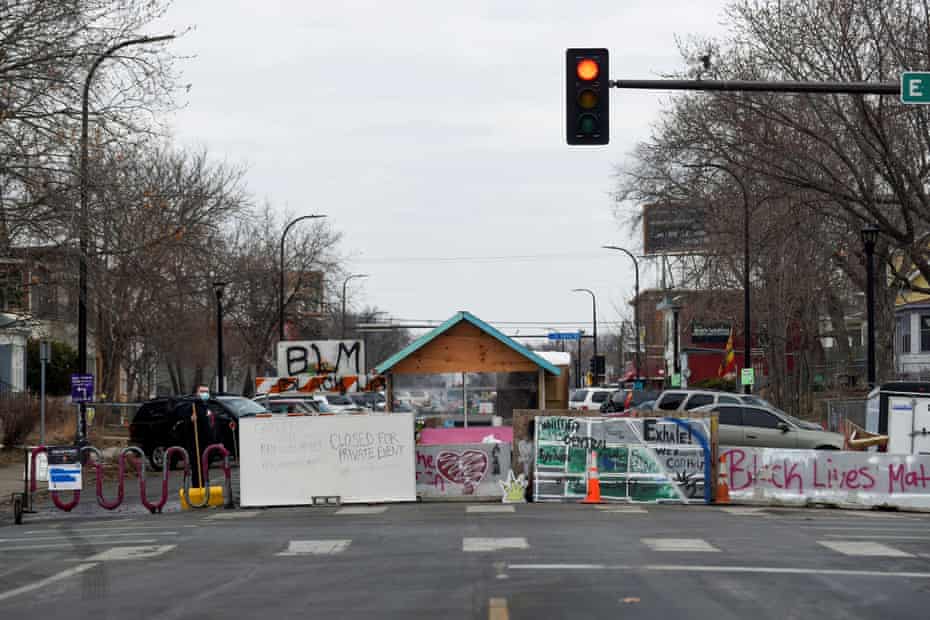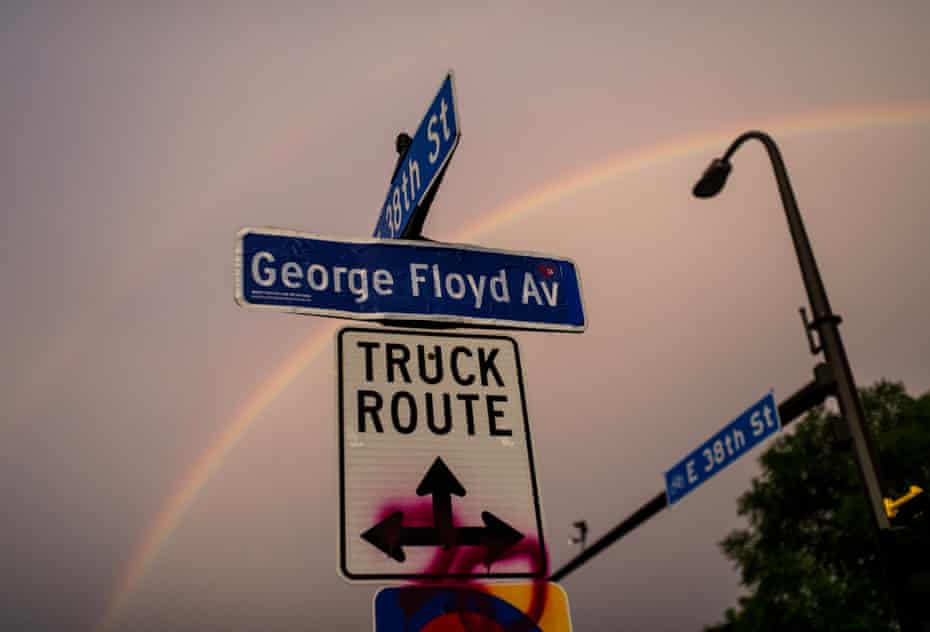The sign on a barricade on a once-unassuming street in Minneapolis reads: “You’re now entering the free state of George Floyd”.
A small rectangle of city blocks features murals, flowers, candles and tributes in the place where Floyd, a Black man, died under the knee of a white police officer last May, sparking the biggest US civil rights uprising since the 1960s.
On maps, it’s the intersection of 38th Street and Chicago Avenue. To activists and community members, it’s George Floyd Square.
But as one of the most significant police trials in US history gets fully under way, of former officer Derek Chauvin, with opening arguments on Monday, the future of the square is also in the balance.
Outside Cup Foods store, where the world watched as a bystander videotaped the 8 minutes, 46 seconds that George Floyd pleaded for his life, one mural depicts a prone body with angel’s wings and some of Floyd’s dying words: “I can’t breathe.”

The area has grown from a makeshift shrine and focus of protests to a semi-autonomous, pedestrian territory symbolizing community resistance.
“I didn’t know that cutting off the street would lead us here. We didn’t ask to be traumatized. We didn’t plan this, we reacted and rode the wave,” said Mileesha Smith.
She grew up in this neighborhood of south Minneapolis, eating at Cup Foods.
“That could be my son,” Smith said of Floyd, looking at the now-iconic wall mural of his face.
She quit her job taking care of elderly people to became one of the volunteer caretakers looking after the square, where she is known to all as “Auntie M”.
“I got off of work to a whole different life,” she said.
Nearby is a disused Speedway gas station now dubbed People’s Way. At a circle of benches with a bonfire pit in the middle, community representatives meet every morning, and activist events are often held there.
There’s a community bookshelf, free donated clothing and toys. Some Saturdays, the local church distributes groceries.
“It’s for the people,” said Willie Frazier, the owner of Finish Touch Boutique, an adjacent Black Lives Matter clothing store. “It’s for everybody in the world that wants to come here.”

And what started as a free clinic in a tent, known as 612Mash (the telephone area code and Minneapolis All Shall Heal), is in the process of becoming a clinic in a building, co-founded by Joelle Zaviska, a nurse.
She brings her 8-year-old son to the square. “As a white woman, this is a great opportunity to show him why we’re here, [that] this can’t happen. None of these things can [be allowed to] happen, like George Floyd.”
Smith described the space as: “Black centered – but it’s not a ‘Black square’.”
Minneapolis mayor Jacob Frey wants to have the barricades down after the trial. The city originally put them up to protect those mourning and protesting from traffic.
“All efforts to reopen the intersection must prioritize both safety and memorialization of George Floyd’s life in this space, one cannot exist without the other,” Frey told the Guardian in an email response to questions.
But there are no details yet on what that could look like or whether it can be achieved with consensus.
The authorities cite an uptick in gun violence and shooting deaths in the square in the last 10 months, with Frey insisting this is causing more pain in the city.
Minneapolis police chief Medaria Arradondo said at a recent press conference: “People are hurting … The best public safety remedy right now is to open up and get that intersection flowing again.”
A group of community members provides some security. There is disagreement about the extent of police access.
“You can be a police officer but why do you have to come in here in uniform and traumatize the people that are here?” Smith said, adding: “It’s not that we don’t want them here, we don’t feel safe.”

George Floyd Square falls between Minneapolis’ eighth and ninth wards, represented respectively by city council member Alondra Cano and council vice-president Andrea Jenkins.
Cano believes reopening the area will reduce a spate of deaths and said: “Crime has increased since the intersection has been blocked off, that’s a fact … gang activity has grown over time” taking advantage of “the sacred space people have tried to create there”.
She speaks of elderly Black residents “feeling unsafe and sleeping in their bathtubs at night because they don’t want to get shot … who have to endure the triggering of trauma and PTSD day after day”.
Jenkins is involved in talks with the community about what should happen next. Enraged by police-involved deaths in Minnesota, she supports reforms to policing and the provision of mental health services, and greater opportunities for businesses, jobs and homeownership in the neighborhood.
She recently told the Guardian that the prospect of Chauvin’s trial was “traumatic” and that the neighborhood of George Floyd Square was struggling amid the aftermath of Floyd’s death and the coronavirus pandemic.
Smith, meanwhile, argued that violence in the community was nothing new but was simply more visible, not “brushed under the rug”.
She believes that Floyd’s death and attention on the square has pulled the curtain back on residents’ problems.
“We’re shining a light on things that people are trying to keep in the dark; we need resources, we need housing, we need jobs,” she said, lamenting inequality and adding: “Why do specific people get a chance at a good education or a good environment?”
Zaviska, the nurse, said she had never felt unsafe within the square.
“Any of the things that happen around here happen in every city, all the time. It’s not special to the space. This is a big community, and everybody here has everyone’s back,” she said.

In the heart of the square stands a tall steel sculpture by local artist Jordan Powell Karis. The iconic Black fist has a pan-African flag atop it and is surrounded by concrete blocks filled with flowers and artwork.
Frank Yellow, who identified himself as a Lakota indigenous man, sat at a booth next to a barrier offering face masks, water and signs to visitors, while watching out to keep the square safe.
“Being from this land, we were supposedly granted autonomy, but we never had that,” he said. “This is an example of how a community can actually operate.”
On the concrete the names of many of those killed by police around the US are inscribed, fading a little after a Minnesota winter.
Frazier, the boutique owner, said the square is a “beautiful thing”, but he appeared to have compromise on his mind. He wants the names of the dead, the murals and other art preserved on an extended sidewalk.
But he added: “Businesses will go under if that street doesn’t open.”








